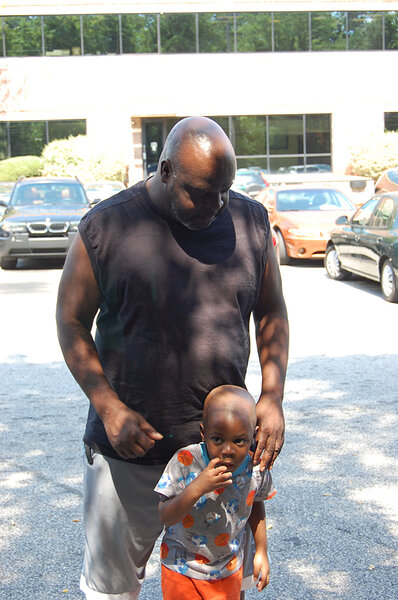The new poor and the almost-poor: Will poverty rate climb more?
Loading...
| Decatur, Ga.
Call them the newly poor. They are the 4.8 million people in America who last year joined the ranks of people living in poverty – defined as having less than $22,000 in annual income for a family of four. They are people, probably, much like Reginald O'Neal and his family.
Mr. O'Neal and several family members were at the Dekalb County welfare department here on Thursday, trying to get help to turn the electricity back on at their house.
"If you were to see our house, you'd think we were middle class," says the 20-something Atlantan. "But that would be missing the point: Lately, we're poor."
These days, a lot of people are feeling worse off that they used to be. But it's the slice of Americans who hadn't quite reached the middle class, yet who were above the poverty line, that is now feeling poverty biting at their heels. With the US unemployment rate stuck well above 9 percent, it's the folks "just below the middle" who account for much of the hike in the US poverty rate, according to at least one poverty expert.
The Census Bureau reported Thursday that the US poverty rate last year hit 14.3 percent, up from 13.2 percent in 2008. Among working Americans, the poverty rate was also the highest its been – 12.9 percent – since 1965.
"Median income remained flat, and the poverty rate went up … which leaves a lot of room for people below the median but previously above the poverty threshold to have shifted downwards," says economist Jim Sullivan, a poverty expert at the University of Notre Dame, in South Bend, Ind. "Just below the middle, that's where a greater toll is being taken."
Paul Carter, maintenance worker who makes about $28,000 a year, is one who is perilously close to that poverty line. He blames food costs and a slow economy for the fact that he had two cars repossessed in the past year.
"Everybody wants people to start spending money again, but there ain't no money around to spend," he says. Though Mr. Carter himself does not take government subsidies, he brought the mother of his three children to the Dekalb County Department of Families and Children on Thursday so she could get help.
Some economists say the new poverty rate might have been higher. The 3.5 percent year-over-year increase in the unemployment rate should have produced an even larger spike in the poverty rate than the Census Bureau reported, they say.
Some dispute the way the poverty number is set. Government benefits such as the Earned Income Tax Credit and food stamps are not counted as household income, and if they were, it might change the calculus that determines who is poor. The tax credit provides about $40 billion a year to lower-middle-class families. Food stamp participants are likely to top 40.5 million by the end of the federal fiscal year, on Sept. 30 – nearly 10 million more than last year.
Tisha Johnson can see in her own life and among her friends what's going on.
Ms. Johnson, a single mom, is trying to start her career as a medical technician, but with no apparent job prospects she is finding herself lodged well below the poverty line. About all she made this year was $3,200 from a temporary Census Bureau job, she says. To make do, she's living with her mom. Her daughter gets financial help from relatives in Connecticut.
"I know a lot of people who are in this boat, moving back home, trying to make ends meet," says Ms. Johnson.
Mr. O'Neal's mother recently lost her job, leaving his stepfather, a self-employed electrician, footing the major bills for their household. Even with the help of food stamps, the family missed enough electric bill payments for Georgia Power to shut off their service.
"My breed of people, we're used to not having, so this isn't really that bad," he says. "We know how to survive."
Judging from clients at food pantries, the profile of the poor has changed in the past two years. "Our callers have changed," says the Rev. Mack Barnes, executive director of the Feed the Hungry Foundation in Atlanta. "More and more calls are from people not used to being in this situation."
Indeed, if poverty is defined less by income and more by factors that have to do with well-being, including the ability to support an accustomed lifestyle, America's real poverty rate may be well above 15 percent, some economists say.
"I think the [Census] income numbers are missing a big part of the hit the Great Recession is putting on people," says Professor Sullivan. That includes "people that are used to making ends meet, who were doing just fine, but they were one bad event away from being in poverty. Then the Great Recession comes along, and there's your bad event."
Democrats on Thursday credited the federal stimulus package and other government assistance for holding the poverty rate below 15 percent.
"There is one primary reason for the fact that poverty did not rise and median income did not fall as much as the rise in the unemployment rate would suggest: government assistance that moderated the effect of the recession on American families," said Commerce Department undersecretary Rebecca Blank, in a statement.
Republicans argued that the Obama administration and its fiscal policies have failed America's poorer residents.
"What poor Americans, like all other Americans, need are jobs, not more government benefits," said Republican Rep. John Linder of Georgia, according to Reuters.





